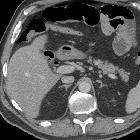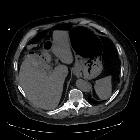Cholezystoduodenale Fistel

Cystic artery
pseudoaneurysm presenting as haematemesis. Round, well-defined, intensely enhancing lesion in gall bladder with enhancement similar to the aorta, suggestive of pseudoaneurysm. Note pericholecystic inflammatory changes and air foci in GB (due to cholecystoduodenal fistula).

Cystic artery
pseudoaneurysm presenting as haematemesis. Intensely enhancing lesion in gall bladder - the pseudoaneurysm is clearly seen arising from the cystic artery.

Gallstone
Ileus with prospective diagnosis of Crohn\"s. Axial CT demonstrating a Cholecystoduodenal fistula with gas in the gallbladder.
Cholecystoduodenal fistula refers to a fistulous connection between the gallbladder and the duodenum. It is considered the most common type of enterobiliary fistulation.
Clinical presentation
Can vary but some can present with Bouveret syndrome or a gallstone ileus.
Radiographic features
CT
CT is considered more accurate than ultrasound and allows direct visualization of a tract between the gallbladder and the duodenum. Pneumobilia may be present as a result .
Treatment and prognosis
According to several papers, laparoscopic cholecystectomy is often successfully performed in these cases .
See also
Siehe auch:

 Assoziationen und Differentialdiagnosen zu Cholezystoduodenale Fistel:
Assoziationen und Differentialdiagnosen zu Cholezystoduodenale Fistel:





